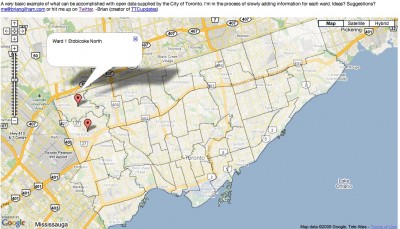
Notes from North of 49ºN
Toronto Mayor David Miller recently unveiled the opening of city datasets on the OpenTO website, ushering in the city’s new era of Gov 2.0. In less than an hour, the above map of the city’s wards was generated from the shapefiles. According to Now Magazine::
“Basically, OpenTO amounts to the city offering up puzzle pieces and the public putting them together. It costs taxpayers next to nothing, creates a wing of local government in which citizens can participate directly, and makes everything more transparent.
At present, not a whole lot of data sets are available. But now that some have been liberated, it won’t be long before others follow.”
While it is true that there isn’t that much data available right now, it’s clear that there are great possibilities here. The openness of the data will allow crowdsourced analysis of urban questions facing Toronto, which is a hotbed of urbanist activity. This ostensibly can create more knowledge for use by Toronto’s Planning Department, as well as grassroots activists, non-profits, entrepreneurs, and corporate interests. The transparency has a flipside. While transparency of data can serve to “keep the city honest,” in the future, as more data goes online, how will individual citizens’ privacy concerns be addressed? For example, should data on ex-convicts {or the like} be listed for public use, such as Megan’s Law databases in the United States? What about data on abandoned property? While this could assist in redevelopment, it might be used for more nefarious purposes.
While data openness is a hallmark of Web 2.0, in terms of policy, what parameters should be in place?
Twitterversion:: @mayormiller’s OpenTO offers #Toronto’s database access, offering Gov2.0 transparency& crowdsourcing opps. #ThickCulture http://url.ie/2tfw
Song:: The Planners Dream Goes Wrong – The Jam

Comments 2
jose marichal — November 8, 2009
Ken...great post. Some of my work looks at how initiatives like these change power arrangements in cities. How does P2P data analysis lead to real changes in urban power dynamics?
Brian Gilham — November 12, 2009
Thanks for showing off my little contribution, Ken! I appreciate it. I'm hoping I can flesh the map out a little bit more in the weeks to come.